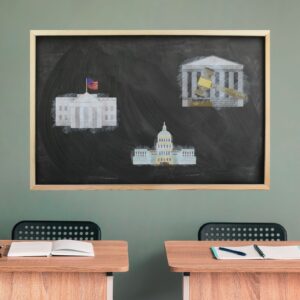
By Amal Ghazalein
Edited by: Muhammed Hani Ahsan and Katie Farrell
Graphic by: Norie Wright
The United States of America, a nation of 335 million people, has spearheaded remarkable technological, science, engineering, and mathematics breakthroughs due to immigrant talent. Yet, legal limitations, emerging from the Immigration Act of 1990, constitute hindrances to enabling the U.S. to unlock its ultimate economic potential. Therefore, Congress must consider taking action to reform the Immigration Act of 1990 in a way consistent with the ever-evolving needs of the U.S. economy.
President George H. W. Bush signed the Immigration Act into law to address the dire labor shortage that US firms endured for years. The Act specifies that 65,000 foreign workers are allowed to enter the United States and work legally in “special occupations1” (INA). Unfortunately, the 65,000 limitation remains stagnant despite numerous changes to the U.S. economy and in many fields across several industries. Presently, American firms are still negotiating the consequences of the manpower deficit, negating the progress that President Bush initiated in 1990. Hence, congress needs to recognize the changes the U.S. economy experienced and propose tangible policies to negotiate these changes, alleviating the economic repercussions that employee shortfall causes.
The benefits of the H-1B visa program are well documented. Not only do H-1Bs alleviate labor shortages, but they also play a key role in job creation for U.S.-born workers. For instance, H-1B visas awarded between 2010 – 2013 created job opportunities in 50 states2. Besides that, H-1Bs led to wage increases by 7% – 8%3 for U.S.-born laborers, and a 1% increase in the share of H-1Bs in an occupation has decreased the unemployment rate by 0.2%4. Similar economic trends are likely to continue if policymakers realize the opportunity H-1Bs possess.
Policymakers must be aware of the fact that the U.S. economy ranks as the top concern for a third of the population, and, therefore, pro-economy legislation should come to the fore in Washington. Accordingly, lawmakers must propose reforms to the Immigration Act of 1990 to make it more dynamic and responsive to the needs of the U.S. economy. To accomplish this, legal reforms must, at the very least, double the current quota for H-1Bs and extend the H-1B program to diverse fields such as finance, art, and agriculture. This step seems to be the most unrealistic since proposals advocating for this change have been brought to the floor by Congress5.
In so doing, the United States would be on track to unlock its economic potential. This necessary reform could serve as a prelude to prosperity and financial security for both American and foreign workers, contributing to the growth of the U.S. economy.
References
[1] U.S. Congress. United States Code: Immigration and Nationality, 8 U.S.C. §§ -1401 Suppl. 2 1964. 1964. Periodical. https://www.loc.gov/item/uscode1964-016008006/.
[2] New American Partnership. The H-1B Employment Effect. http://www.newamericaneconomy.org/wp-content/uploads/2015/04/H1B_Effect.pdf
[3] Ruiz, Neil, and Jens Manuel Krogstad. Salaries have Risen for High-skilled Foreign Workers in U.S. on H-1B Visas. Pew Research Center. 2017
[4] Ruiz, Neil, and Jens Manuel Krogstad. Salaries have Risen for High-skilled Foreign Workers in U.S. on H-1B Visas. Pew Research Center. 2017
[5] Anderson, Stuart. The Outlook on H-1B Visas and Immigration in 2023. Forbes. https://www.forbes.com/sites/stuartanderson/2023/01/03/the-outlook-on-h-1b-visas-and-immigration-in-2023/?sh=15ff26826980





